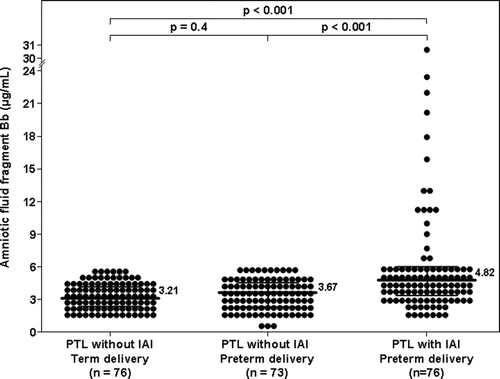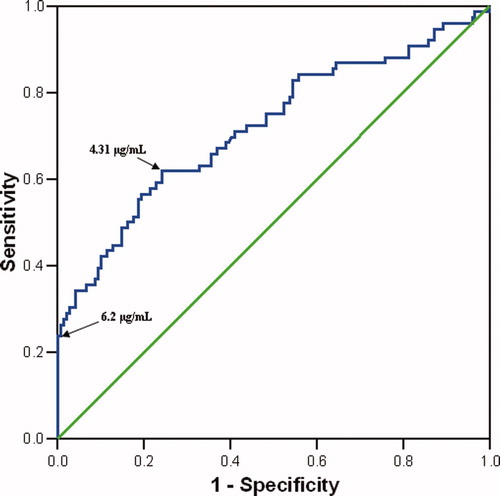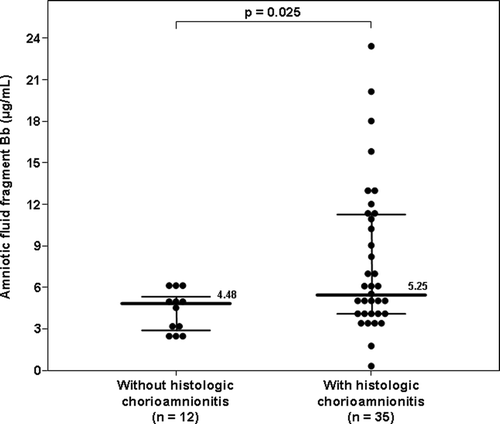Figures & data
Table I. Demographic and clinical characteristics of patients with a normal pregnancy in the mid-trimester and those at term, with and without spontaneous labor.
Table II. Demographic and clinical characteristics of patients presenting with spontaneous preterm labor (PTL) and intact membranes.
Table III. Demographic and clinical characteristics of patients presenting with preterm prelabor rupture of membranes (preterm PROM).
Figure 1. Amniotic fluid concentration of fragment Bb in normal pregnancies in the mid-trimester and at term, with and without spontaneous labor: The median amniotic fluid concentration of fragment Bb was higher in women at term not in labor than in those in the mid-trimester [term not in labor: 2.42 μg/ml, IQR 1.78–3.22 vs. mid-trimester: 1.64 μg/ml, IQR 1.06–3.49; p < 0.001]. Among women at term, the median amniotic fluid fragment Bb concentration did not differ between patients with spontaneous labor and those not in labor (term in labor: 2.47 μg/ml, IQR 1.86–3.22; p = 0.97).
![Figure 1. Amniotic fluid concentration of fragment Bb in normal pregnancies in the mid-trimester and at term, with and without spontaneous labor: The median amniotic fluid concentration of fragment Bb was higher in women at term not in labor than in those in the mid-trimester [term not in labor: 2.42 μg/ml, IQR 1.78–3.22 vs. mid-trimester: 1.64 μg/ml, IQR 1.06–3.49; p < 0.001]. Among women at term, the median amniotic fluid fragment Bb concentration did not differ between patients with spontaneous labor and those not in labor (term in labor: 2.47 μg/ml, IQR 1.86–3.22; p = 0.97).](/cms/asset/5f5f29e7-1810-45eb-87c7-fc417f8251e4/ijmf_a_399638_f0001_b.gif)
Figure 2. Amniotic fluid concentration of fragment Bb in women with spontaneous preterm labor and intact membranes: The median amniotic fluid concentration of fragment Bb was higher in patients with IAI than in those without IAI who delivered preterm (PTL 4.82 μg/ml, IQR 3.32–6.08 vs. 3.67 μg/ml, IQR 2.35–4.57; p < 0.001), as well as than that of those who delivered at term (3.21 μg/ml, IQR 2.39–4.16; p < 0.001). Among women with PTL without IAI, there was no significant difference in the median amniotic fluid fragment Bb concentration between patients who delivered preterm and those who delivered at term (p = 0.4).

Figure 3. Amniotic fluid concentration of fragment Bb in women with preterm prelabor rupture of membranes (preterm PROM): The median amniotic fluid concentration of fragment Bb was higher in patients with IAI than in those without IAI (4.24 μg/ml, IQR 2.58–5.79 vs. 2.79 μg/ml, IQR 2.09–3.89; p < 0.001).

Figure 4. Receiver–operating characteristic (ROC) curve of amniotic fluid fragment Bb concentration of patients with PTL and intact membranes for the identification of IAI (n = 225, area under the curve 0.72, p < 0.001).

Table IV. Diagnostic indices and likelihood ratios of amniotic fluid fragment Bb concentration for the detection of intra-amniotic infection/inflammation in patients presenting with spontaneous preterm labor with intact membranes (n = 225).
Figure 5. Amniotic fluid concentration of fragment Bb in women with spontaneous PTL, intact membranes and IAI who delivered within 72 h of amniocentesis and have placental histopathologic diagonsis: Among women with IAI, the median amniotic fluid concentration of fragment Bb was higher in patients with histologic chorioamnionitis than in those without (5.25 μg/ml, IQR 3.97–11.27 vs. 4.48 μg/ml, IQR 2.80–5.29; p = 0.025).
